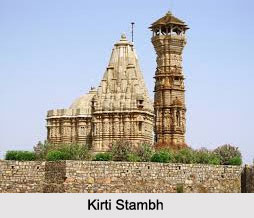 Kirti Stambha is a medieval monument in Rajasthan. This fort was built in 12th Century AD that is in the medieval era during time of Delhi Sultanate.
Kirti Stambha is a medieval monument in Rajasthan. This fort was built in 12th Century AD that is in the medieval era during time of Delhi Sultanate.
Location of Kirti Stambha
Kirti Stambh is a 12th-century tower situated at Chittorgarh fort in Rajasthan.
Height of Kirti Stambha
Kirti Stambha is about 22 metres high tower. This was originally an old minar in Chittorgarh fort and was built much before Vijaya Stambha.
Architecture of Kirti Stambha
Kirti Stambha was built by a Jain merchant Jeeja Bhagerwala during the reign of Rawal Kumar Singh who ruled the modern days Rajasthan and Gujurat from 1179-1191 for the glory of Jainism in western part of India. The tower is built in the Solanki style. It is 30 feet wide at the base and narrows down to 15 feet at the top.
History of Kirti Stambha
Chittor in Rajsthan is one of the most famous of all forts in India. It is famous for the story of Padmini taking part in Jauhar when Alauddin Khilji had besieged the fort. The fort has a history going back several centuries. It was an ancient centre of Jain tradition. Chittor is adjacent to the ancient city of Madhyamika, an ancient town in Rajasthan where Buddhism was spread. The Jain inscriptions at Mathura from the Kushana Dynasty period (1st to 3rd centuries) mention a "Majjhimilla" branch of the "Kottiya" gana, indicating that it was a major Jain centre.
Kirti Stambha and Chittorgarh Fort
Kirti Stambha was the residence of Jinavallabha who propagated the Vidhimarga in the 12th century. From the 15th to 17th centuries, it was the seat of a Bhattaraka.
Inscriptions of Kirti Stambha
The three inscriptions of Kirti Stambha have been found that mention Jija of Bagherwal community as the builder of the pillar of Jain inscriptions. One of the inscriptions mentioned Dharmakirti, the disciple of Shubhakirti, who was disciple of Vasantkirti. According to the Balatkara Gana Pattavali, Dharmakirti headed the patta during 1224-1257. Thus the structure of Kirti Stambha dates from the 13th century, although an unrelated Jain inscription of 896 was found in the vicinity. Kirti Stambh of Chittorgarh fort is older than another tower in the same Chittor fort, known as the Vijay Stambha which is known as the Tower of Victory, which is dedicated to Lord Vishnu. Vijay Stambha is the architecture of Chittorgarh. Vijay Stambha was constructed by Mewar king Rana Kumbha in the year 1448 to commemorate the victory over the combined armies of Malwa, Rajasthan and Gujarat led by Mahmud bin Khilji.



















